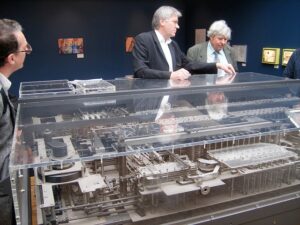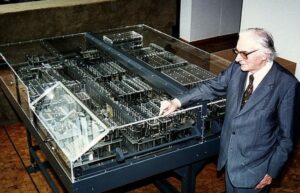
Today it is practically impossible to imagine living without a computer. Although many people go through it and do not have one in their home, computers help us both directly and indirectly to have an easier daily life. From banks, schools and educational institutes to government entities, premises, restaurants and practically any type of business, place and place usually have one, and the reasons for this abound.
However, as you surely know or at least imagine, computers have not always been as we know them. Until a few decades ago, they were very impractical, not very functional, heavy, huge, and very expensive. Moreover, they were machines that were marketed with very little success since their use was very limited, at least for ordinary users. This applies more to the world's first computer, which was launched in the last century and the one we talk about below.
Z1, the world's first computer

There have been many computers that have been considered the first to be released in the world. However, the Z1 is the first to be programmable, which is why it is known as the first in history, although there is a lot of discrepancy in this regard, since there are other computers that are known as the first in the world, but the majority of the historians give to the Z1 like the deserving of this title. At the same time, this machine was the first to use Boolean logic and binary floating point numbers.
The Z1 computer was designed by Konrad Zuse, a German engineer who later designed other successor models. At its launch, which was in 1938, it was known as the best calculator in the world, although it has also received other titles, and two of them are "The first electromechanical programmable binary computer" and "the first functional home computer for the general public." In addition to this, the engineer Zuse took a few years to design and build it, so it was from 1936 that he began to give it life, although some data suggests that it could be from 1935, one year less.
Although it was thought to market the Z1 as a residential device for the homes of the average user, the truth is it was not entirely practical, it was also somewhat large, which prevented it from attracting special attention from the consuming public. This was the main reason why it did not reach the market as such, as well as the fact that weighed about 1 ton, among other things.
What the Z1 looked like: features and design

Not to mention again the fact that the Z1 was a really heavy machine that made it very difficult to transport and market, this computer was really big, taking up an entire common table. But nevertheless, I was considered small back then, so it was a step forward in that sense. Let us remember that we are talking about an ancient time, in which technological advances at the computer level were in their infancy.
This machine was based on about 20,000 pieces, so, at the same time, it was difficult to build and replicate. It had a reading system that processed information, data and calculations through punched tapes using an 8-bit code. At the same time, it boasted a single electrical unit that fulfilled the role of an electric motor and supported a 1 Hz clock frequency (cycle per second) to the machine to perform mathematical calculations in a matter of seconds, something that for the era was fast, but that, for today, is a very poor figure.
For the construction, among many other materials, the German engineer Zuse used "thin metal strips" and probably "metal cylinders" or glass plates to build the computer.

Zuse started construction at his parents' apartment in Germany. Specifically, the machine was developed in the living room of the house, in the middle of everything. There he was working on it for a long time. In the process, the engineer quit his main job, which was at the aircraft factory, to be on the Z1 full-time.
Got money from different sources, since he alone could not afford all the materials, much less the different tasks to build it. His parents were one of the main economic promoters of his project, as well as his sister Lieselotte. Some students of the AV Motiv fraternity and Kurt Pannke, a manufacturer that at that time made calculating machines in Berlin, Germany, also had credit in this regard.
What could I do?

The Z1 computer was not capable of doing much, really, and its response times and calculations were good, but at that time, it is worth noting. In question, he could perform addition in 5 seconds and multiplication in twice the time, about 10 seconds. At least, that was the average computing speed of this machine.
For subtraction and division, it took him, respectively, about 5 seconds and 20 seconds at most. Of course, the time also depended on the figures, they were very high or not. Beyond that, this computer was not capable of other activities.
Where are you currently?
For reasons of war conflicts at the time, the Z1 computer was destroyed in 1943 thanks to the bombings and airstrikes by the country's allies.
It was not until 33 years later, in 1986, that the Free University of Berlin approved the project to rebuild it so that Zuse would give life to the device again.
Sketches for the rebuild were started by Zuse in 1984, but it wasn't until 1986 that the Z1 was put into operation again. It is currently on display in Berlin, Germany, at the city's Traffic and Technology Museum, and is presented there as an invaluable historical piece and heritage.
An interesting fact is that the replica is so exact that its operation is not perfect, just like the original Z1.
Successor models
The Z1 machine gave way for other computers in the same family to be built by Zuse. The engineer, with the desire to improve his designs and final results more and more, brought to life four more models, which are the Z2, Z3, Z4 and Z22.
Z2
The Z2, more than anything else, was an experimental machine that Zuse, together with Helmut Schreyer as an assistant, created in 1940. It was an attempt to make the mechanics of the Z1 work better, since it did not work well and had errors in the calculations, tasks and processes.
The engineer opted to make the computer with thermionic valves, but back then there was a very short supply of this component and it was extremely difficult to acquire it for the Z2. Due to this and problems of the war conflicts, it was not a successful project and it was totally destroyed in the same year it was built, in 1940.
Z3
The Z3 computer is considered as the first fully automatic programmable machine. It was created in 1941 and managed to reach a clock frequency of 5 Hz, which was 5 times that of the Z1.
This model was a real improvement on the Z1, as opposed to the Z2, which it was a failure. However, it was destroyed in 1943 thanks to a bombing in the city of Berlin. A replica is currently on display in the German Museum in Munich, Germany.
Z4
The Z4 was another great improvement on the previous models already mentioned. However, it was not a much smaller and lighter computer. This one, almost like the Z1, weighed about 1,000 kg, being another very difficult machine to design and build.
This was built by Konrad Zuse and his company Zuse KG between 1941 and 1945, although technically it was completed in 1944. However, after that, several tweaks and modifications were added, for about a year, making it not fully ready until 1945.
Its operation was based on punch card reading, something that back then made programming a lot easier. This is thanks to the fact that one of the final touches of this device was the implementation of a punch card reader unit, something that Zuse came up with in the end. It is also important to say that this was the first commercial model and is currently located in the Museum in Munich, Germany.
Z22
There were other models like the Z5 and Z11, but it was not until the Z22 that there was a great generational leap in the famous German's computers. It was another Zuse business computer and its design ended in 1955, to later be sold in Berlin and Aachen.
This apparatus worked at a clock frequency of 3 kHz. In addition, it was very easy to program and came with instructions for it, making it easy for anyone without any mathematical and computer skills to use it. It was much more modern, at the design level, and today it is on display at the University of Applied Sciences, Karlsruhe.